Revolving Doors 101: Specifying a more energy-efficient, secure opening

By Bob Augustine and Elias Campos
Revolving doors have been manufactured for over a century. Theophilus Van Kannel was granted U.S. patent 387,571 on August 7, 1888 for a “Storm-door Structure” that was a three-partition revolving door. Since then, their general benefits have remained the same—creating comfort, saving energy, improving traffic flow, and enhancing security. The design of these doors eliminates drafts and keeps debris from entering the building.
A revolving door is essentially a freestanding vestibule. What makes these doors unique is they are always open and receptive to pedestrians, but simultaneously always closed to the outside elements. This second point means less escape of the building’s conditioned air or penetration by the exterior. Empirical studies (discussed later in this article) demonstrate revolving doors are approximately eight times more energy-efficient than slide- or swing-door systems.
They are viewed as a cold-climate solution, but heightened awareness of the need to conserve energy has increased their use in warmer regions—it is just as important to keep air-conditioning in the building. Over the past two decades, revolving doors have also been sold to meet security requirements in both Fortune 500 companies and airports.
Configurations and safety considerations
Typically, revolving doors are made up of the components illustrated in Figure 1. The products generally come in four, three, and two-wing configurations; each offers advantages the architect typically matches to the building use and design. Additionally, the specifier has the ability to select either a segmented or round drum. Various benefits to the designs are listed in Figure 2.
For both Canada and the United States, revolving doors are designed, manufactured, and installed per American National Standards Institute (ANSI) A156.27, Power and Manual Operated Revolving Pedestrian Doors. For manual systems, the primary safety control is to limit the rotating speed with canopy- or floor-mounted controls. The maximum allowable speed is 12 rotations per minute (rpm).
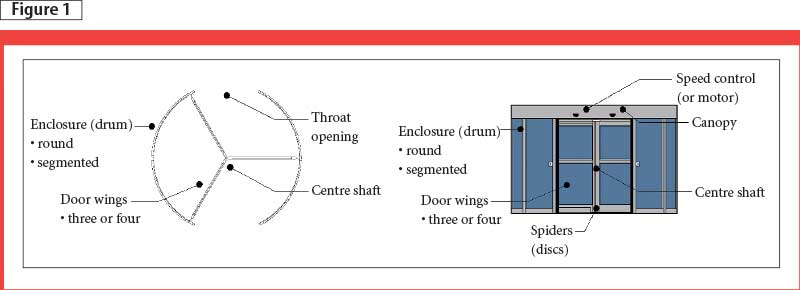 Automatic revolving doors are furnished with a series of active and passive sensors. These are similar to those for the automatic swinging and sliding doors. For wing safety, ANSI A156.27 Section 16.1 requires the sensors to detect a 711-mm (28-in.) tall person in the rotating path a minimum of 254 mm (10 in.) from the wing (Figure 3).
Automatic revolving doors are furnished with a series of active and passive sensors. These are similar to those for the automatic swinging and sliding doors. For wing safety, ANSI A156.27 Section 16.1 requires the sensors to detect a 711-mm (28-in.) tall person in the rotating path a minimum of 254 mm (10 in.) from the wing (Figure 3).
Automatic revolving doors also require entry-point sensors to prevent entrapment at the intersection of the rotating wing and the approaching drum wall. The ANSI standard calls for these sensors to detect the presence of a person or object when the door wing approaches, and stop the rotation (Figure 4).
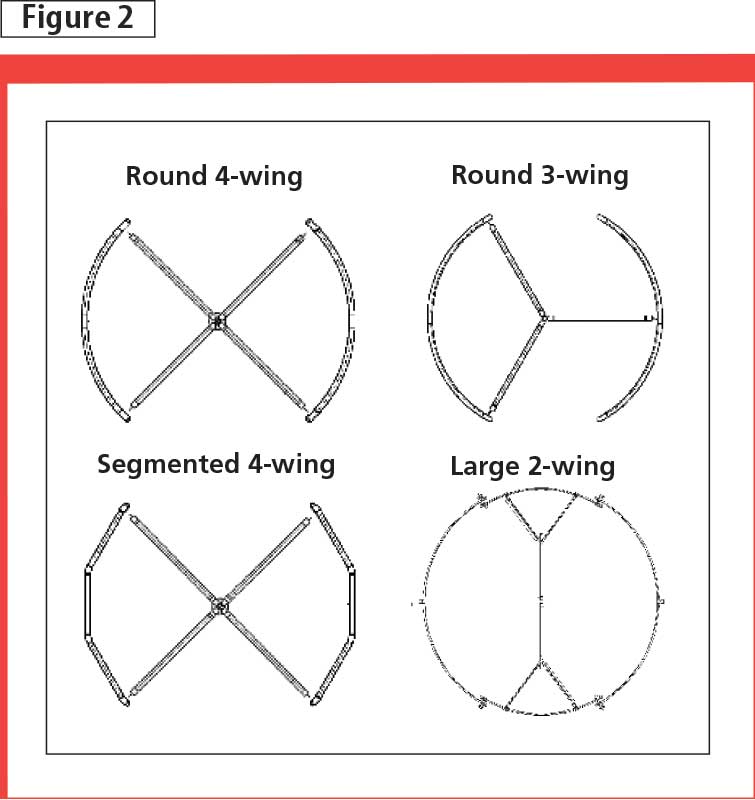 In addition to the wall sensor, the drum edge farthest from the rotating wing is furnished with a contact safety edge. This edge, according to ANSI A156.27 Section 17.1, is required to detect any 44.5 N (10-lbf) obstruction (or greater) and immediately stop the door rotation. This redundant protection ensures enhanced safety to pedestrians and peace of mind to business owners and overall traffic (Figure 5).
In addition to the wall sensor, the drum edge farthest from the rotating wing is furnished with a contact safety edge. This edge, according to ANSI A156.27 Section 17.1, is required to detect any 44.5 N (10-lbf) obstruction (or greater) and immediately stop the door rotation. This redundant protection ensures enhanced safety to pedestrians and peace of mind to business owners and overall traffic (Figure 5).
The bottom rail of the wing is typically furnished with a ‘toe-guard’ sensor. Under ANSI A156.27 Section 17.2, sensors are designed to detect an obstruction no more than 1.2 m (4 ft) from the floor and with less than 44.5 N of pressure, and then stop the door rotation. It is intended to eliminate the possibility of a person’s heel being trapped under the wing (Figure 6).
Further, Section 20.1 of ANSI A156.27 requires the furnishing of emergency buttons. These are designed to remove the power of an automatic door; they must be located on both sides of the door and stop its rotation until reset (Figure 7).
Revolving doors connect to the surrounding infrastructure either at the ‘throat’ or at the centre (Figure 8). The selection is typically dictated by design. For example, an option to consider is whether it is possible to have a portion of the revolving door on the sidewalk. A cropped canopy gives the flexibility to install a revolving door flush with the storefront. With the door being throat-connected, the revolving door stays inside the building. This design could reduce interference with pedestrian traffic using the sidewalks. For most standalone buildings, the centre-connected option is the norm.
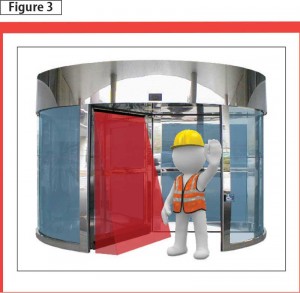
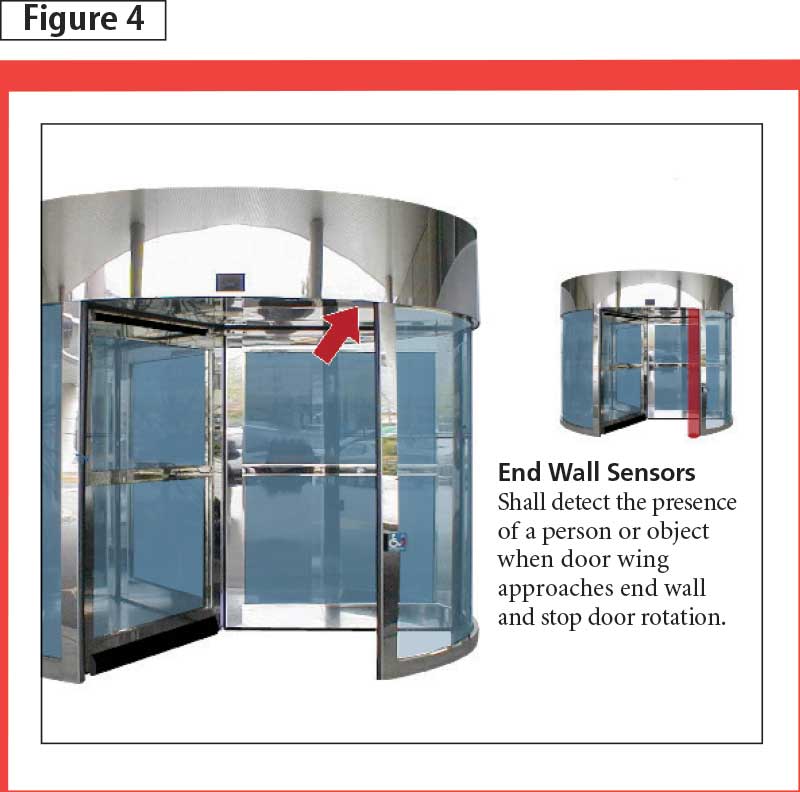
Specifying the right product
Critical to all designs and applications is an understanding of the particular building’s use and traffic patterns. There are four main possibilities:
- manual doors;
- automatic doors;
- security doors; and
- exit lane turnstile revolving doors.
Manual doors
Typical applications for manual revolving doors include:
- banks;
- stores;
- restaurants;
- conference centres; and
- universities.
These openings can accommodate large volumes of traffic in both directions. The choice between a three- or four-wing design depends on the application and the people using the entrance. The latter option provides a slightly larger throughput as four people in each direction can pass through the door with each revolution; additionally, the throat opening is larger. Consequently, it is recommended on higher-volume applications where capacity is a concern such as a conference centre or university.
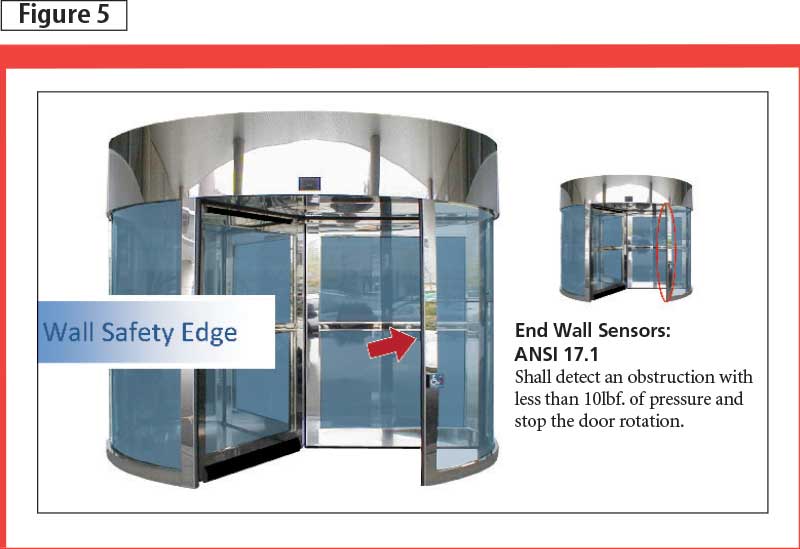
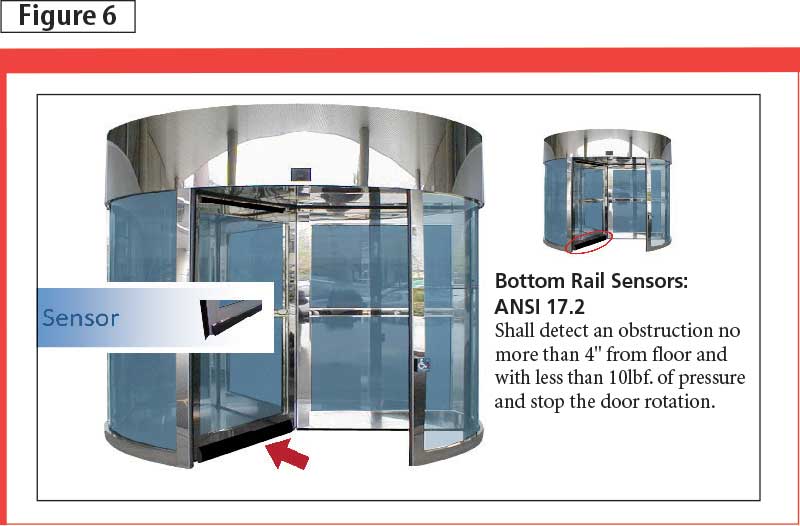
A three-wing design is preferable in a hotel application where the larger compartment size is more critical. Guests at a hotel typically have rolling or carried luggage and the larger compartment size is more suitable. Some grocery stores and restaurants use three-wing doors to accommodate a parent with a child conveniently in the same compartment. Most manual doors are supplied in diameter sizes of 1.9, 2.1, or 2.4 m (6 ½, 7, or 8 ft).
Automatic doors
With the need for hands-free operation, the typical applications for automatic revolving doors include airports, hotels, casinos, and hospitals. These doors can accommodate larger items like golf clubs and skis, but they are also used in healthcare applications as they can deal with wheelchairs and those walking with assistance.
Automatic revolving doors are installed when one needs to conveniently move larger volumes of people through a front entrance while maintaining high energy efficiency standards. Choices in automatic revolving doors are two-, three-, and four-wing; they are typically 3 m (10 ft) in diameter and larger.
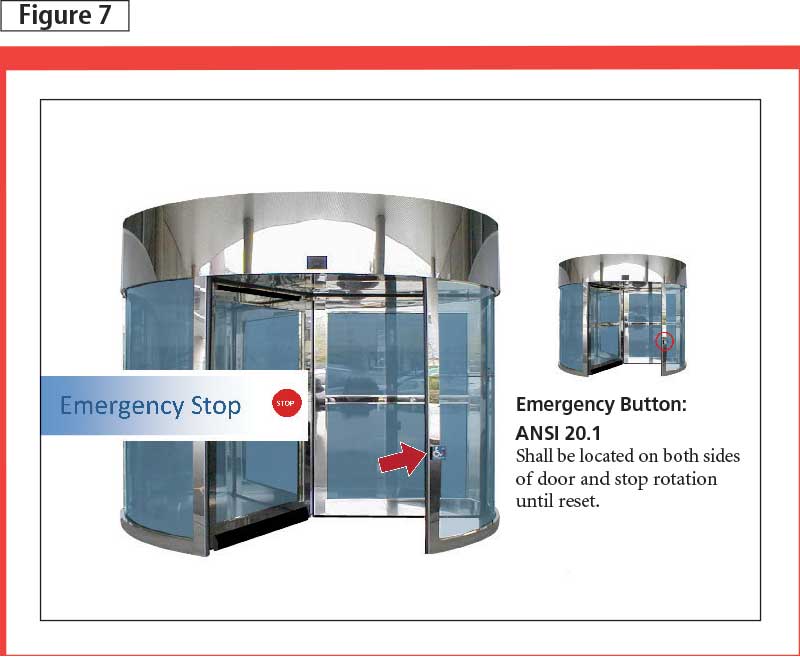
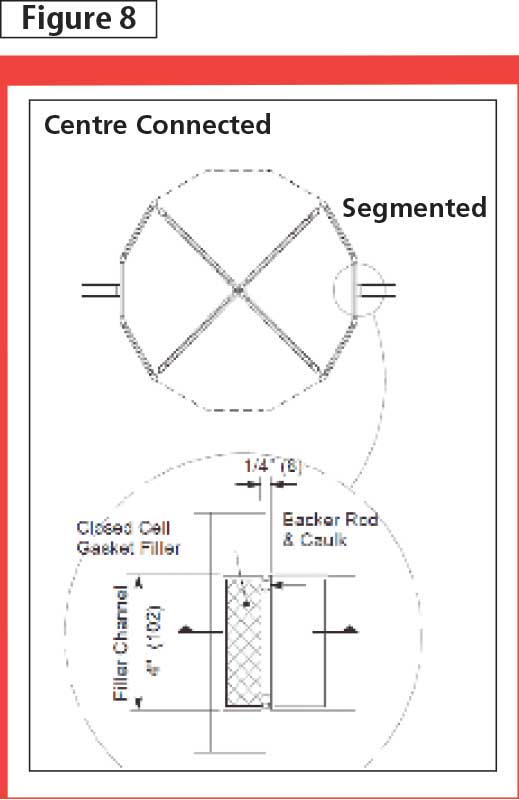
The two-wing design offers the largest compartment size and the best airlock. In a hospital application, this assembly can accommodate gurneys. It offers the largest compartment size as there is no centre shaft or core. The entire door, including the ceiling, rotates on a channel installed in the canopy.
It offers the best airlock because in lieu of a single, centre core there are two—one on each of the wings. These cores completely close the throat opening to outside elements and are desirable in cold climates to prevent ice and snow from entering the throat opening during non-operating hours. When the wings completely close the throat opening, this is the only revolving door that is not ‘always open and always closed’ during part of its rotation.
Due to the increased mechanical components necessary for this configuration, including the rotating ceiling, the two-wing is typically more costly than comparable three- or four-wing alternatives.







